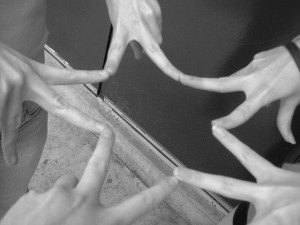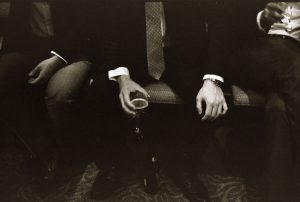 [Read Lauren Camp’s “The Day You Stop” HERE]
[Read Lauren Camp’s “The Day You Stop” HERE]
One day will be tomorrow. The day of truce
and socket and beaten. The day
you shrink into stopping, the day threadbare and pain-
shamed and limit. Until then,
you might be continuing
because that is what you do until the last moment
when you must stop.
Of course it is like this. Always. The Planning Self, the Conscientious Self, the Fantasy-Stopping Self: all too often separate from the one required to carry out the behavioral change. Let’s call her The Stopping Self: that walking-the-talk part of us intent on carrying all our good intentions to fruition, or in this case, termination.
This poem also alludes to the mind games that we play with those other parts of ourselves, our cognitive biases, which get in the way of the simple causal reasoning of “This is really not good for my well-being, so why don’t I just stop doing it?”
Take my/our ongoing struggle to regulate our consumption of food and drink. Writing this piece on a Saturday morning, somewhat foggy-headed from a bit too much of a Friday night treat-yourself tipple, I am sipping my second cup of Assam tea with soy milk, and I have no inclination at this moment whatsoever to drink wine or beer for the rest of the weekend. Maybe not for the rest of my life. Certainly not this evening. Nor to eat processed food or sugary snacks like biscuits or cake. Assam tea, Lauren’s poem, and my thoughts after learning it by heart this week, are all I require of the moment to make it good enough to exist in and for. And yet this is not a Friday Night or Saturday Evening Self thinking and writing.
This is the self that in Schema Therapy is known as The Healthy Adult, which some might say is a Core Self, but others might recognise it as just another entity from the Carousel of Selves: The Stopping Self, The Impulsive Self, The Woebegone Self, all the visitors to Rumi’s Being-Human Guest House.
You will stop for some weeks,
your body taking body
from your blood
and the back of the throat,
and those weeks will be thank-you-God acres
of erasure and resurrection and the clabber of other small prayers
you stoop to collect. You will be diligent
because you have paid good money
to be taught how to stop, slanting off
from queasy transgressions, those
clutches and source.
Welcome to the Hot-Cold Empathy Gap where we disremember the fact that pretty much everything we do, feel, or think is state dependent. My current slightly-hungover mode is good for “cold” conscientious note-taking and unprofaned, clean-living forecasts for the day. As soon as I have written about learning this poem, I will go and work in the garden, and maybe do some yoga, and tidy and declutter, and plough through the rest of that Sapolsky tome I’ve been trying to read for the last week, struggling to concentrate long enough to stay with it for more than a few chapters.
Our Carousel of Selves, can also, broadly speaking, be mapped onto neural networks. The hero of the piece, the Healthy Adult /Stopping Self is a probably a more metaphorical way of talking about the Frontal Cortex. Sapolsky gives us a handy job description for this member of our inner team:
“Its list of expertise includes working memory, executive function (organizing knowledge strategically, and then initiating an action based on an executive decision), gratification postponement, long-term planning, regulation of emotions, and reining in impulsivity.”
And here’s Camp on Impulsivity, that moment when we give way to our desires:
the unwashed swell of rapture
taking your face through teeth to heartbeat,
every beaten moment on the couch.
Every relief: have hereafter and clamor.
Have nothing worse.
You’ll follow the mumble through
that ache that is tincture. Is rule
and bundle. Is famished inside you
and thrumming.
The Stopping Part, the frontal cortex, to return to Sapolsky for a moment “makes you do the harder thing when it’s the right thing to do.” The Stopping Self finds resourceful ways to override, dodge, or ride out the wave of desire that seems to come out of nowhere, building at times, to tsunami-proportions: “the unwashed swell of rapture / taking your face through teeth to heartbeat”.
The Stopping Self is a right old party-pooper. But also perhaps it is this age-old tussle between those Platonic horses of desire and reason, with us feeling quite often like the poor old Charioteer trying to keep these conflicted nags on the same course.
The Frontal Cortex/Stopping Self turns out to be the most recently evolved brain region, “not approaching full splendor until the emergence of primates; a disproportionate percentage of genes unique to primates are active in the frontal cortex. Moreover, such gene expression patterns are highly individuated, with greater interindividual variability than average levels of whole-brain differences between humans and chimps.” (Sapolsky)
I remember some years ago, going to see Jonathan Safran Foer talk about his book Eating Animals and him saying in response to a question suggesting that it is in our nature as omnivores to eat meat that in fact we are most human when we’re struggling with our impulse to chew down on a nice juicy beefburger as opposed to going for the ethically more sound lentil alternative. I think this poem makes these questions particularly alive for us, which is one of the reasons why I wanted to learn it by heart.
If you had to choose
between settle and suture, you know what you’re after.
You’d pour yourself hitches
and battery. Pour yourself each subsequent time.
I still have no idea what behaviour is being targeted in this poem for cessation. As I spend the week learning it by heart, taking it into my lungs and belly, I sometimes think we’re discussing an eating disorder, or maybe it’s smoking, perhaps even narcotics. Or is it alcohol?
In many ways, all our addictions are interchangeable. In the Brahmajāla Sutta, Siddhārtha Gautama (aka the Buddha) gives us a role call of his society’s addictions, big and small, which still reads today, for all its elephants, buffaloes, bulls, and rams, as thoroughly contemporary listicle:
“Some ascetics and Brahmins…remain addicted to attending such shows as dancing, singing, music, displays, recitations, hand-music, cymbals and drums, fairy shows;…combats of elephants, buffaloes, bulls, rams;…manoeuvres, military parades;…disputation and debate, rubbing the body with shampoos and cosmetics, bracelets, headbands, fancy sticks…unedifying conversation about kings, robbers, ministers, armies, dangers, wars, food, drink, clothes…heroes, speculation about land and sea, talk of being and non-being.”
I think of alcohol more often than not as I learn the poem, but perhaps that’s my projection of choice. But there are some indicators in the language of the poem, in its talk of “liquefying” resolve, and “pouring”, perhaps in the sense of both losing control as well as in the enactment of the compulsion. Or maybe it is some other addiction altogether. I like the fact that I don’t really know either way, and nor do I need to know because it is the process and function here of our compulsions that are being explored, and we readers will read ourselves and our own struggles with these unruly selves into the poem. This is why we read poetry, isn’t it? This is why I read poetry: to inhabit that perimeter where parts of “me” intermingle and amalgamate with parts of you.
Still everywhere the shiver
is slow on the tongue, insistent. You will stop
for some weeks,
your body taking body
from your blood
and the back of the throat,
and those weeks will be thank-you-God acres
of erasure and resurrection and the clabber of other small prayers
you stoop to collect
This is certainly how my Monday-Friday often works. Sometimes only Monday to Wednesday. And even on a Friday night, because I cannot trust The Addict, I will stand in the liquor aisle of the supermarket and wrangle with compulsive Steve.
“Now you know the deal, you cannot be trusted with a bottle of wine, as you will drink the whole thing, so we allow you two small 187ml single-serves”
“But I don’t like the wine in the single-serves.”
“Too bad, it’s that or nothing.”
“Harumph. OK, two single-serves. And what about getting two more for tomorrow while they’re on special offer?”
“Are you sure you won’t drink all four tonight. Because that would defeat the whole thing.”
“Of course.”
Even so,
we shouldn’t fool ourselves;
resolve cannot liquefy need.
Of course. We shouldn’t fool ourselves, even though The Addict manages to do just that. One. More. Time.
What is it to be addicted? I think we can all recognise those moments in our life that adhere to this channnel of desire:
You’ll follow the mumble through
that ache that is tincture. Is rule
and bundle. Is famished inside you
and thrumming.
Having read a good amount of the addiction literature for my dayjob, as well as having talked this through with hundreds of patients and myself, I think I’ve now got a better understanding what the need is. It’s not particularly arcane. It’s a need to shift from some state of discomfort or suffering into a less aversive one. We might be talking Big D&S (Discomfort & Suffering), or one of the small itchy varieties we may all experience at the end of a working week: a tiredness, an emptiness, some low-grade discontent which spurs the yearning to be soothed, satisfied, liberated from these feelings of not-feeling-ok, not-being-ok. Which is why, unless we officially class ourselves as Alcoholics, or Sex, or Food Addicts, Big and commit ourselves to a Twelve-Step program in line with our falling off, we will probably find ourselves living the hot-cold see-saw described in Camp’s poem over and over and over again.
It will become impossible to believe
you will ever stop for good.
Stopping is not counter or suspect,
but easing back is all that is left,
the impulse has got you, it’s all that survives.
The wisdom of the poem seems to suggest that maybe one can find through an act of self-acceptance some peace with whatever addictive swing or see-saw we happen to be playing with.
Or is there a more explicit moral stance being played out here, suggesting that unless we find a way to get on top of our impulses, we lose some intrinsic part of our humanity: “the impulse has got you, it’s all that survives”. The Addict, as she’s quite happy to do, takes over and runs the whole show.THE DAY YOU STOP
One day will be tomorrow. The day of truce
and socket and beaten. The day
you shrink into stopping, the day threadbare and pain-
shamed and limit. Until then,
you might be continuing
because that is what you do until the last moment
when you must stop.
Still everywhere the shiver
is slow on the tongue, insistent. You will stop
for some weeks,
your body taking body
from your blood
and the back of the throat,
and those weeks will be thank-you-God acres
of erasure and resurrection and the clabber of other small prayers
you stoop to collect. You will be diligent
because you have paid good money
to be taught how to stop, slanting off
from queasy transgressions, those
clutches and source. Even so,
we shouldn’t fool ourselves;
resolve cannot liquefy need.
You will probably start again soon after
you have completed the stopping,
the unwashed swell of rapture
taking your face through teeth to heartbeat,
every beaten moment on the couch.
Every relief: have hereafter and clamor.
Have nothing worse.
You’ll follow the mumble through
that ache that is tincture. Is rule
and bundle. Is famished inside you
and thrumming. You understand
there are two types, and you are
the type to release. If you had to choose
between settle and suture, you know what you’re after.
You’d pour yourself hitches
and battery. Pour yourself each subsequent time.
It will become impossible to believe
you will ever stop for good.
Stopping is not counter or suspect,
but easing back is all that is left,
the impulse has got you, it’s all that survives.
-Lauren Camp
—
RECOVERY
You have decided to live. This is your fifth
day living. Hard to sleep. Harder to eat,
the food thick on your tongue, as I watch you,
my own mouth moving.
Is this how they felt after the flood? The floor
a mess, the garden ruined,
the animals insufferable, cooped up so long?
So much work to be done.
The sodden dresses. Houses to be built.
Wood to be dried and driven and stacked. Nails!
The muddy roses. So much muck about. Hard walking.
And still a steady drizzle,
the sun like a morning moon, and all of them grumpy
and looking at each other in that new way.
We walk together, slowly, on this your fifth day
and you, occasionally, glimmer with a light
I’ve never seen before. It frightens me,
this new muscle in you, flexing.
I had the crutches ready. The soup simmering.
But now it is as we thought.
Can we endure it, the rain finally stopped?
-Marie Howe
—
I HAVE ROADS IN ME
winding within my arteries
into distant hills
of memories,
where dreams float like dandelion fibers
on bright, chill, breezy
mornings under a canopy
of cottonwood branches.
Where leaves glimmer
sunlight
roads turn.
I have roads in me
where drums pound a sacrifice
and beckon
to again believe in life’s wonder,
where I learn the intense passion,
seeing the sparkling, dewdripping
leaves upon moist, pine-needled ground.
My heart restored,
I am guided
by stars
and a raging desire to live.
-Jimmy Santiago Baca
—
LOUDMOUTH SOUP
Vodka, whiskey, gin. Scotch, Red wine, cognac,
brandy—are you getting thirsty yet?—ale,
rye. It all tastes good: on the rocks, with a splash,
side of soda, shaken
not stirred, triple,
olives, one of those nutritious little pearl
onions, a double, neat,
with a twist. Drink
it up. Let’s have a drink: dry beer, wet beer,
light, dark and needled beer. Oh parched,
we drank the river
nearly to its bed at times, and were so numb
a boulder on a toe
was pleasant pain, all pain
was pleasant since that’s all there was, pain,
and everything that was deeply felt, deeply,
was not. Bourbon, white and pink wine, aperitif,
cordial (hardly!), cocktail, martini,
highball, digestif, port, grain
punch—are you getting thirsty yet?—line them up!
We’ll have a drink
and talk, we’ll have
a drink
and die, grim-about-it-with-piquancy.
It was a long time on the waiting list
for zero
and I’m happy
for the call out of that line
to other, less predictable,
more joyful
slides to ride on home.
-Thomas Lux
—
THE IRREPARABLE
Can we stifle the old, the lingering Remorse,
That lives, quivers and writhes,
And feeds on us like the worm on the dead,
Like the grub on the oak?
Can we stifle implacable Remorse?
In what philtre, in what potion, what wine,
Shall we drown this old enemy,
Destructive and greedy as a harlot,
Patient as the ant?
In what philtre, in what potion, what wine?
Tell it, fair sorceress, O! tell it, if you know,
To this spirit filled with anguish,
So like a dying man crushed beneath the wounded,
Who is struck by the horses’ shoes;
Tell it, fair sorceress, O! tell it, if you know,
To this dying man whom the wolf already scents
And whom the crow watches,
To this broken soldier! if he must despair
Of having his cross and his grave,
This poor, dying man whom the wolf already scents!
Can one illuminate a black and miry sky?
Can one tear asunder darkness
Thicker than pitch, without morning, without evening,
Without stars, without ominous lightning?
Can one illuminate a black and miry sky?
Hope that shines in the windows of the Inn
Is snuffed out, dead forever!
Without the moon, without light, to find where they lodge
The martyrs of an evil road!
The Devil has put out all the lights at the Inn!
Adorable sorceress, do you love the damned?
Say, do you know the irremissible?
Do you know Remorse, with the poisoned darts,
For whom our hearts serve as targets?
Adorable sorceress, do you love the damned?
The Irreparable gnaws with his accurst teeth
Our soul, pitiful monument,
And often he attacks like the termite
The foundations of the building.
The Irreparable gnaws with his accurst teeth!
— Sometimes I have seen at the back of a trite stage
Enlivened by a deep-toned orchestra,
A fairy set ablaze a miraculous dawn
In an infernal sky;
Sometimes I have been at the back of a trite stage
A being who was only light, gold and gauze,
Throw down the enormous Satan;
But my heart, which rapture never visits,
Is a playhouse where one awaits
Always, always in vain, the Being with gauze wings!
-Charles Baudelaire, tr. Aggeler
—
THE HEAVENS
From mind to mind
I am acquainted with the struggles
of these stars. The very same
chemistry wages itself minutely
in my person.
It is all one intolerable war.
I don’t care if we’re fugitives,
we are ceaselessly exalted, rising
like the drowned out of our shirts…
-Denis Johnson
—
AMERICAN RIVER SKY ALCOHOL FATHER
What is pornography? What is dream?
American River Sky Alcohol Father,
forty years ago, four lifetimes ago,
brown as bourbon, warm, you said to me,
“Sorry sorry sorry sorry sorry.”
Then: “You’re killing your mother.”
And she: “You’re killing your father.”
What do men want? What do fathers want?
Why won’t they go to the mothers?
(What do the mothers want.)
American River Sky Alcohol Father,
your warm hand. Your glass. Your bedside table gun.
The dock, the water, the fragile, tough beach grass.
Your hand. I wouldn’t swim. I wouldn’t fly.
-Jean Valentine
—
BREATHINGS
i checked him every night
mixing the landing light
with the slow mucous of his snores
if he was quiet I would press
two fingers on his arm
until he breathed again
children need so little air
but i wake every hour
gasping for yesterday
choking on the things
i did not do
the times i did not listen
i check him still
opening his old room
like a tin beneath my bed–
-Dom Conlon
—
CORRESPONDENCE
I leave it there
For a while
Like some jagged thing
Until foolish hope
Overcomes hollow experience
And I am told
That the beating heart
I stuffed with the unbroken spiral
Of a small, round apple
And glazed all over
With dark, sticky blood
Was not quite right
I leave it again
Until I tire of the tiny nicks
Each time I pass it by
Then reconcile it
To the rejection heap
Along with the others
That also taught me nothing
And I take up my blade
-Anne Casey
—
DELINQUENT HEARTS ON THE RAILROAD TRACKS
Eat the shrooms and desire me. We tag
the car, our tailing Fs and Ss rising
off the rusted side. You say the paint cans
hiss like the king snake curled up under your porch.
I laugh and jake, vodka gunning. The highway
is a distant thrum. When you smash the caboose window
with a rock in your fist I know the drugs are working.
We nimble along the tracks back to stashed
bottles filled with gas and oil. When the train
rolls by we toss and laugh and streak as fire
consumes the side of the cars. It’s a dragon
you brag, and high we rise up over crappy
lives we knuckle drag. We drink and smoke and tag
and dodge the railroad cops bobbing for our necks.
It’s just after midnight and the laughs still come.
I’ve got a scheme to avoid being caught.
When you touch me I know you want me forever.
-Stephen Scott Whitaker
—
DREAM SONG #57
In a state of chortle sin—once he reflected,
swilling tomato juice—live I, and did
more than my thirstier years.
To Hell then will it maul me? for good talk,
and gripe of retail loss? I dare say not.
I don’t thínk there’s that place
save sullen here, wherefrom she flies tonight
retrieving her whole body, which I need.
I recall a ‘coon treed,
flashlights, & barks, and I was in that tree,
and something can (has) been said for sobriety
but very little.
The guns. Ah, darling, it was late for me,
midnight, at seven. How in famished youth
could I forsee Henry’s sweet seed
unspent across so flying barren ground,
where would my loves dislimn whose dogs abound?
I fell out of the tree.
-John Berryman
—
IF THERE’S A GOD
If there’s a god of amphetamine, he’s also the god of
wrecked lives, and it’s only he who can explain how my doctor
father, with the gift of healing strangers and patients alike,
left so many intimate dead in his wake.
If there’s a god of amphetamine, he’s also the god of
recklessness, and I ask him to answer.
He’s the god of thrills, the god of boys riding bikes down
steep hills with their hands over their heads.
He’s the god of holy and unholy chance, the god of soldiers
crossing a field and to the right of you a man falls dead and to
the left also and you are still standing.
If there’s a god of amphetamine, he’s the god of diet pills,
who is the god of the Fifties housewife who vacuums all day and
whose bathroom is spotless and now it is evening as she sits
alone in the kitchen, polishing her chains.
He’s the god of the rampant mind and the god of my father’s
long monologues by moonlight in the dark car driving over the
dusty roads.
He’s the god of tiny, manic orderings in the midst of chaos,
the god of elaborate charts where Greg will do this chore on
Monday and a different one on Tuesday and all the brothers are
there on the chart and all the chores and all the days of the
week in a miniscule script no one can read.
If there’s a god of amphetamine, my father was his hopped-up
acolyte who leapt out of bed one afternoon to chase a mouse
through the house, shouting, firing his .38 repeatedly at the
tiny beast scurrying along the wall while Jon wailed for help
from the next room.
If there’s a god of amphetamine, he’s the god of subtle
carnage and dubious gifts who lives in each small pill that
tastes of electricity and dust.
If there’s a god of amphetamine, my father was its high
priest, praising it, preaching its gospel, lifting it like a host
and intoning: “Here in my hand is the mystery– a god alive
inside a tiny tablet. He is a high god, a god of highs– he eats
the heart to juice the brain and mocks the havoc he makes,
laughing at all who stumble. Put out your tongue and receive it.”
-Gregory Orr
—
GRAVY
No other word will do. For that’s what it was.
Gravy.
Gravy, these past ten years.
Alive, sober, working, loving, and
being loved by a good woman. Eleven years
ago he was told he had six months to live
at the rate he was going. And he was going
nowhere but down. So he changed his ways
somehow. He quit drinking! And the rest?
After that it was all gravy, every minute
of it, up to and including when he was told about,
well, some things that were breaking down and
building up inside his head. “Don’t weep for me,”
he said to his friends. “I’m a lucky man.
I’ve had ten years longer than I or anyone
expected. Pure Gravy. And don’t forget it.
-Raymond Carver
—
POETRY COLLECTIONS:
William Brewer’s I Know Your Kind
Kaveh Akbar’s Calling a Wolf a Wolf
If you have further suggestions for poems or collections on this theme, could you please leave a note in the Comments box below. Thank you!
THE DAY YOU STOP
One day will be tomorrow. The day of truce
and socket and beaten. The day
you shrink into stopping, the day threadbare and pain-
shamed and limit. Until then,
you might be continuing
because that is what you do until the last moment
when you must stop.
Still everywhere the shiver
is slow on the tongue, insistent. You will stop
for some weeks,
your body taking body
from your blood
and the back of the throat,
and those weeks will be thank-you-God acres
of erasure and resurrection and the clabber of other small prayers
you stoop to collect. You will be diligent
because you have paid good money
to be taught how to stop, slanting off
from queasy transgressions, those
clutches and source. Even so,
we shouldn’t fool ourselves;
resolve cannot liquefy need.
You will probably start again soon after
you have completed the stopping,
the unwashed swell of rapture
taking your face through teeth to heartbeat,
every beaten moment on the couch.
Every relief: have hereafter and clamor.
Have nothing worse.
You’ll follow the mumble through
that ache that is tincture. Is rule
and bundle. Is famished inside you
and thrumming. You understand
there are two types, and you are
the type to release. If you had to choose
between settle and suture, you know what you’re after.
You’d pour yourself hitches
and battery. Pour yourself each subsequent time.
It will become impossible to believe
you will ever stop for good.
Stopping is not counter or suspect,
but easing back is all that is left,
the impulse has got you, it’s all that survives.
-Lauren Camp
—
RECOVERY
You have decided to live. This is your fifth
day living. Hard to sleep. Harder to eat,
the food thick on your tongue, as I watch you,
my own mouth moving.
Is this how they felt after the flood? The floor
a mess, the garden ruined,
the animals insufferable, cooped up so long?
So much work to be done.
The sodden dresses. Houses to be built.
Wood to be dried and driven and stacked. Nails!
The muddy roses. So much muck about. Hard walking.
And still a steady drizzle,
the sun like a morning moon, and all of them grumpy
and looking at each other in that new way.
We walk together, slowly, on this your fifth day
and you, occasionally, glimmer with a light
I’ve never seen before. It frightens me,
this new muscle in you, flexing.
I had the crutches ready. The soup simmering.
But now it is as we thought.
Can we endure it, the rain finally stopped?
-Marie Howe
—
I HAVE ROADS IN ME
winding within my arteries
into distant hills
of memories,
where dreams float like dandelion fibers
on bright, chill, breezy
mornings under a canopy
of cottonwood branches.
Where leaves glimmer
sunlight
roads turn.
I have roads in me
where drums pound a sacrifice
and beckon
to again believe in life’s wonder,
where I learn the intense passion,
seeing the sparkling, dewdripping
leaves upon moist, pine-needled ground.
My heart restored,
I am guided
by stars
and a raging desire to live.
-Jimmy Santiago Baca
—
LOUDMOUTH SOUP
Vodka, whiskey, gin. Scotch, Red wine, cognac,
brandy—are you getting thirsty yet?—ale,
rye. It all tastes good: on the rocks, with a splash,
side of soda, shaken
not stirred, triple,
olives, one of those nutritious little pearl
onions, a double, neat,
with a twist. Drink
it up. Let’s have a drink: dry beer, wet beer,
light, dark and needled beer. Oh parched,
we drank the river
nearly to its bed at times, and were so numb
a boulder on a toe
was pleasant pain, all pain
was pleasant since that’s all there was, pain,
and everything that was deeply felt, deeply,
was not. Bourbon, white and pink wine, aperitif,
cordial (hardly!), cocktail, martini,
highball, digestif, port, grain
punch—are you getting thirsty yet?—line them up!
We’ll have a drink
and talk, we’ll have
a drink
and die, grim-about-it-with-piquancy.
It was a long time on the waiting list
for zero
and I’m happy
for the call out of that line
to other, less predictable,
more joyful
slides to ride on home.
-Thomas Lux
—
THE IRREPARABLE
Can we stifle the old, the lingering Remorse,
That lives, quivers and writhes,
And feeds on us like the worm on the dead,
Like the grub on the oak?
Can we stifle implacable Remorse?
In what philtre, in what potion, what wine,
Shall we drown this old enemy,
Destructive and greedy as a harlot,
Patient as the ant?
In what philtre, in what potion, what wine?
Tell it, fair sorceress, O! tell it, if you know,
To this spirit filled with anguish,
So like a dying man crushed beneath the wounded,
Who is struck by the horses’ shoes;
Tell it, fair sorceress, O! tell it, if you know,
To this dying man whom the wolf already scents
And whom the crow watches,
To this broken soldier! if he must despair
Of having his cross and his grave,
This poor, dying man whom the wolf already scents!
Can one illuminate a black and miry sky?
Can one tear asunder darkness
Thicker than pitch, without morning, without evening,
Without stars, without ominous lightning?
Can one illuminate a black and miry sky?
Hope that shines in the windows of the Inn
Is snuffed out, dead forever!
Without the moon, without light, to find where they lodge
The martyrs of an evil road!
The Devil has put out all the lights at the Inn!
Adorable sorceress, do you love the damned?
Say, do you know the irremissible?
Do you know Remorse, with the poisoned darts,
For whom our hearts serve as targets?
Adorable sorceress, do you love the damned?
The Irreparable gnaws with his accurst teeth
Our soul, pitiful monument,
And often he attacks like the termite
The foundations of the building.
The Irreparable gnaws with his accurst teeth!
— Sometimes I have seen at the back of a trite stage
Enlivened by a deep-toned orchestra,
A fairy set ablaze a miraculous dawn
In an infernal sky;
Sometimes I have been at the back of a trite stage
A being who was only light, gold and gauze,
Throw down the enormous Satan;
But my heart, which rapture never visits,
Is a playhouse where one awaits
Always, always in vain, the Being with gauze wings!
-Charles Baudelaire, tr. Aggeler
—
THE HEAVENS
From mind to mind
I am acquainted with the struggles
of these stars. The very same
chemistry wages itself minutely
in my person.
It is all one intolerable war.
I don’t care if we’re fugitives,
we are ceaselessly exalted, rising
like the drowned out of our shirts…
-Denis Johnson
—
AMERICAN RIVER SKY ALCOHOL FATHER
What is pornography? What is dream?
American River Sky Alcohol Father,
forty years ago, four lifetimes ago,
brown as bourbon, warm, you said to me,
“Sorry sorry sorry sorry sorry.”
Then: “You’re killing your mother.”
And she: “You’re killing your father.”
What do men want? What do fathers want?
Why won’t they go to the mothers?
(What do the mothers want.)
American River Sky Alcohol Father,
your warm hand. Your glass. Your bedside table gun.
The dock, the water, the fragile, tough beach grass.
Your hand. I wouldn’t swim. I wouldn’t fly.
-Jean Valentine
—
BREATHINGS
i checked him every night
mixing the landing light
with the slow mucous of his snores
if he was quiet I would press
two fingers on his arm
until he breathed again
children need so little air
but i wake every hour
gasping for yesterday
choking on the things
i did not do
the times i did not listen
i check him still
opening his old room
like a tin beneath my bed–
-Dom Conlon
—
CORRESPONDENCE
I leave it there
For a while
Like some jagged thing
Until foolish hope
Overcomes hollow experience
And I am told
That the beating heart
I stuffed with the unbroken spiral
Of a small, round apple
And glazed all over
With dark, sticky blood
Was not quite right
I leave it again
Until I tire of the tiny nicks
Each time I pass it by
Then reconcile it
To the rejection heap
Along with the others
That also taught me nothing
And I take up my blade
-Anne Casey
—
DELINQUENT HEARTS ON THE RAILROAD TRACKS
Eat the shrooms and desire me. We tag
the car, our tailing Fs and Ss rising
off the rusted side. You say the paint cans
hiss like the king snake curled up under your porch.
I laugh and jake, vodka gunning. The highway
is a distant thrum. When you smash the caboose window
with a rock in your fist I know the drugs are working.
We nimble along the tracks back to stashed
bottles filled with gas and oil. When the train
rolls by we toss and laugh and streak as fire
consumes the side of the cars. It’s a dragon
you brag, and high we rise up over crappy
lives we knuckle drag. We drink and smoke and tag
and dodge the railroad cops bobbing for our necks.
It’s just after midnight and the laughs still come.
I’ve got a scheme to avoid being caught.
When you touch me I know you want me forever.
-Stephen Scott Whitaker
—
DREAM SONG #57
In a state of chortle sin—once he reflected,
swilling tomato juice—live I, and did
more than my thirstier years.
To Hell then will it maul me? for good talk,
and gripe of retail loss? I dare say not.
I don’t thínk there’s that place
save sullen here, wherefrom she flies tonight
retrieving her whole body, which I need.
I recall a ‘coon treed,
flashlights, & barks, and I was in that tree,
and something can (has) been said for sobriety
but very little.
The guns. Ah, darling, it was late for me,
midnight, at seven. How in famished youth
could I forsee Henry’s sweet seed
unspent across so flying barren ground,
where would my loves dislimn whose dogs abound?
I fell out of the tree.
-John Berryman
—
IF THERE’S A GOD
If there’s a god of amphetamine, he’s also the god of
wrecked lives, and it’s only he who can explain how my doctor
father, with the gift of healing strangers and patients alike,
left so many intimate dead in his wake.
If there’s a god of amphetamine, he’s also the god of
recklessness, and I ask him to answer.
He’s the god of thrills, the god of boys riding bikes down
steep hills with their hands over their heads.
He’s the god of holy and unholy chance, the god of soldiers
crossing a field and to the right of you a man falls dead and to
the left also and you are still standing.
If there’s a god of amphetamine, he’s the god of diet pills,
who is the god of the Fifties housewife who vacuums all day and
whose bathroom is spotless and now it is evening as she sits
alone in the kitchen, polishing her chains.
He’s the god of the rampant mind and the god of my father’s
long monologues by moonlight in the dark car driving over the
dusty roads.
He’s the god of tiny, manic orderings in the midst of chaos,
the god of elaborate charts where Greg will do this chore on
Monday and a different one on Tuesday and all the brothers are
there on the chart and all the chores and all the days of the
week in a miniscule script no one can read.
If there’s a god of amphetamine, my father was his hopped-up
acolyte who leapt out of bed one afternoon to chase a mouse
through the house, shouting, firing his .38 repeatedly at the
tiny beast scurrying along the wall while Jon wailed for help
from the next room.
If there’s a god of amphetamine, he’s the god of subtle
carnage and dubious gifts who lives in each small pill that
tastes of electricity and dust.
If there’s a god of amphetamine, my father was its high
priest, praising it, preaching its gospel, lifting it like a host
and intoning: “Here in my hand is the mystery– a god alive
inside a tiny tablet. He is a high god, a god of highs– he eats
the heart to juice the brain and mocks the havoc he makes,
laughing at all who stumble. Put out your tongue and receive it.”
-Gregory Orr
—
GRAVY
No other word will do. For that’s what it was.
Gravy.
Gravy, these past ten years.
Alive, sober, working, loving, and
being loved by a good woman. Eleven years
ago he was told he had six months to live
at the rate he was going. And he was going
nowhere but down. So he changed his ways
somehow. He quit drinking! And the rest?
After that it was all gravy, every minute
of it, up to and including when he was told about,
well, some things that were breaking down and
building up inside his head. “Don’t weep for me,”
he said to his friends. “I’m a lucky man.
I’ve had ten years longer than I or anyone
expected. Pure Gravy. And don’t forget it.
-Raymond Carver
—
POETRY COLLECTIONS:
William Brewer’s I Know Your Kind
Kaveh Akbar’s Calling a Wolf a Wolf
If you have further suggestions for poems or collections on this theme, could you please leave a note in the Comments box below. Thank you!
Threaded through my thoughts I’ve included some pictures from one of my favourite photographers, Claire Martin, taken from her Downtown East Side photo essay. Even if you have never seen these pictures of destitution and addiction before, I’m sure they are painfully familiar to us as a type. And here lies a certain comfort, but also another kind of nefarious “fooling ourselves”. Most likely our socioeconomic privileges keep us on the “right” side of social respectability, and yet the machinery of addiction is exactly the same, whether your compulsive behaviour is checking your Twitter and Facebook updates in ways that disrupt the flow of your day, or shopping for classical music in a compulsive manner, as Gabor Maté admits in another classic of addiction literature In The Realm of The Hungry Ghosts:
“Addictions are often interchangeable—a fact that further buttresses the unitary theory that there’s a common addiction process. Although my addictive tendencies are most obvious in my compact-disc-buying habit, I can shift seamlessly into other obsessive activities….I have thrown myself equally blindly and avidly into political work and other pursuits. I’ve even had several of my addictions up and running at the same time. That is, the addiction process was active and looking for more and more external trophies to capture. For all that, the anxiety, ennui and fear of the void driving the whole operation rarely abated.”
I love this book by Maté because at a certain point in the book, he takes off the distanced, expert MD jacket in which he starts the book, the doctor’s coat he wears each day as he carries out his work in harm reduction clinics in Vancouver’s Downtown Eastside, assisting many of the people Claire Martin photographs in her essay, and becomes one of us flawed mortals. Maté, the wounded healer, identifies very strongly with his patients who struggle with mental and physical health issues alongside their addictions. What separates them he realises is more a case of systematic racial and economic inequality as opposed to the willpower myth, that if you try hard enough, you can overcome anything — abuse, poverty, hardship, and the most destructive of our addictions. Camp’s poem doesn’t buy into this willpower idea either, and neither should we.
Even so,
we shouldn’t fool ourselves…
Or if we do, at least let’s do it with some of the kindness and understanding midst the frustration and struggle that this poem embodies.
 What is truly glorious about this late poem from Stevens, who is often landed with the mantle of difficult or “philosophical” poet, is the intense simplicity and directness with which he interrogates that perennial question “Why Poetry?”.
What is truly glorious about this late poem from Stevens, who is often landed with the mantle of difficult or “philosophical” poet, is the intense simplicity and directness with which he interrogates that perennial question “Why Poetry?”. It is here that Stevens, like a wily Prospero starts to play with us. If we file poems under the category Makings of the Sun (the word “other” suggests he does), then who wrote these poems? What is Ariel up to when they’re not serving Prospero? Do they exist, unconsciously, like some of the other makings of the sun – the plants and trees, animals and weather? Or are they more like us, conscious, often painfully self-conscious agents of our own makings?
It is here that Stevens, like a wily Prospero starts to play with us. If we file poems under the category Makings of the Sun (the word “other” suggests he does), then who wrote these poems? What is Ariel up to when they’re not serving Prospero? Do they exist, unconsciously, like some of the other makings of the sun – the plants and trees, animals and weather? Or are they more like us, conscious, often painfully self-conscious agents of our own makings? Helen Vendler, still the most perspicacious commentator on Stevens, and maybe on poetry in general, reminds us in her book Wallace Stevens: Words Chosen Out of Desire that Stevens is the poet of Desire, although not frequently thought of in this way. Especially when it comes to overmastering and mercilessly renewed desire: “Each moment of reflection, for him, is a rebirth of impulse toward fulfillment, as desire reaches for its object—sexual, religious, epistemological, or (encompassing them all) aesthetic. Hunger, for Stevens, is our eternal condition: famished for fulfillment, we achieve it uncertainly and not for long, but radiantly nonetheless.”
Helen Vendler, still the most perspicacious commentator on Stevens, and maybe on poetry in general, reminds us in her book Wallace Stevens: Words Chosen Out of Desire that Stevens is the poet of Desire, although not frequently thought of in this way. Especially when it comes to overmastering and mercilessly renewed desire: “Each moment of reflection, for him, is a rebirth of impulse toward fulfillment, as desire reaches for its object—sexual, religious, epistemological, or (encompassing them all) aesthetic. Hunger, for Stevens, is our eternal condition: famished for fulfillment, we achieve it uncertainly and not for long, but radiantly nonetheless.” Why the word lineament? Well, predominantly, we are talking about lines here. Lines of poetry, but also the outline that makes everything exist as it is, that seperates one living form from another. Rivers are lines, trees are lines, we are lines (stick figures!) the whole of existence a series of largely separate, but occasionally intersecting lines.
Why the word lineament? Well, predominantly, we are talking about lines here. Lines of poetry, but also the outline that makes everything exist as it is, that seperates one living form from another. Rivers are lines, trees are lines, we are lines (stick figures!) the whole of existence a series of largely separate, but occasionally intersecting lines.
 What I’m calling the blahs may be the blues, or maybe a cousin of the blues. It presents itself as a general abatement of interest, gratification, and faith in the offerings of the world. It is a state in which the monotony of equivalence holds sway. Roethke
What I’m calling the blahs may be the blues, or maybe a cousin of the blues. It presents itself as a general abatement of interest, gratification, and faith in the offerings of the world. It is a state in which the monotony of equivalence holds sway. Roethke  THE PATIENCE OF ORDINARY THINGS
THE PATIENCE OF ORDINARY THINGS The Superego is particularly hot on what we might call black and white thinking, a concept that is as old as psychology itself, going back all the way Pierre Janet’s notions about dissociation which forms the bedrock to ideas hold about personality and “taste”. Freud first wrote of the Superego, which he called the Ego-Ideal in his essay On Narcissism, describing the processes by which we internalize the idealized objects of infantile love (our parents), providing us then with a libidinal bridge across which to make contact (cathect) with the world around us. Borrowing the strength of these parental gods, fortified by teachers and other authority figures (literary critics, as well as the hive-mind of various media) we begin to fall under the spell of these outer, then inner injunctions and prohibitions in the form of conscience or morality or taste. As far as literature is concerned: this poem kosher (meaning “proper”), this poem traif (improper, “torn”, from the last verse of Exodus: “you must not eat flesh torn by beasts in the field; to the dogs you shall cast it.”).
The Superego is particularly hot on what we might call black and white thinking, a concept that is as old as psychology itself, going back all the way Pierre Janet’s notions about dissociation which forms the bedrock to ideas hold about personality and “taste”. Freud first wrote of the Superego, which he called the Ego-Ideal in his essay On Narcissism, describing the processes by which we internalize the idealized objects of infantile love (our parents), providing us then with a libidinal bridge across which to make contact (cathect) with the world around us. Borrowing the strength of these parental gods, fortified by teachers and other authority figures (literary critics, as well as the hive-mind of various media) we begin to fall under the spell of these outer, then inner injunctions and prohibitions in the form of conscience or morality or taste. As far as literature is concerned: this poem kosher (meaning “proper”), this poem traif (improper, “torn”, from the last verse of Exodus: “you must not eat flesh torn by beasts in the field; to the dogs you shall cast it.”). The Social Media Superego (henceforth SMS) would most likely ignore this poem because it is written by an 83-year old heterosexual white woman and falls into a genre that one might broadly label as “spiritual”, even religious. Had it come from the pen of of another straight, white septua-,octo-, or even nonogenarian writer, one of the more edgy darlings of SMS (Jean Valentine, Joan Didion, Bernadette Mayer, Alice Notley, Renata Adler, Diana Athill), it would no doubt be celebrated, which is to say retweeted avidly by the most active Twitter demographic, 18 – 29 year-olds.
The Social Media Superego (henceforth SMS) would most likely ignore this poem because it is written by an 83-year old heterosexual white woman and falls into a genre that one might broadly label as “spiritual”, even religious. Had it come from the pen of of another straight, white septua-,octo-, or even nonogenarian writer, one of the more edgy darlings of SMS (Jean Valentine, Joan Didion, Bernadette Mayer, Alice Notley, Renata Adler, Diana Athill), it would no doubt be celebrated, which is to say retweeted avidly by the most active Twitter demographic, 18 – 29 year-olds. The Canonical Superego is often at war with The Social Media Superego, and would probably give SMS favourites (Smith, Vuong, Akbar, say) as well as Pat Schneider a wide berth. Schneider because she is (so it tells me) “two-a-penny common in the kind of poetry she writes”. “Twee” is a word the Canonical Superego uses when talking about this poem. With regard to my SMS favourites, it might label them as a form of modish froth or spume tossed about on the transient waves of literary fashion. The Canonical Superego is to a greater or lesser extent misogynistic, racist, and elitist. Not a good combo.
The Canonical Superego is often at war with The Social Media Superego, and would probably give SMS favourites (Smith, Vuong, Akbar, say) as well as Pat Schneider a wide berth. Schneider because she is (so it tells me) “two-a-penny common in the kind of poetry she writes”. “Twee” is a word the Canonical Superego uses when talking about this poem. With regard to my SMS favourites, it might label them as a form of modish froth or spume tossed about on the transient waves of literary fashion. The Canonical Superego is to a greater or lesser extent misogynistic, racist, and elitist. Not a good combo. The Indisputable Superego is perhaps not as vocal or as visible as the other two, perhaps because it doesn’t really have to convince you of much. For its taste in art or literature is…well…Indisputable. Which is to say that not even Social Media Superego or Canonical Superego would have a problem with me byhearting an Elizabeth Bishop poem. “Yes of course you love Bishop,” they say and smile at each other, half-surprised at being briefly in agreement. I’m trying to think of the select few writers who the Indisputable Superego might champion: perhaps you can help me out with this? Writers who are edgy enough to please SM Superego as well as firmly cemented into the canon. Samuel Beckett? Hopkins? Thoreau? Dostoevsky? DeLillo?
The Indisputable Superego is perhaps not as vocal or as visible as the other two, perhaps because it doesn’t really have to convince you of much. For its taste in art or literature is…well…Indisputable. Which is to say that not even Social Media Superego or Canonical Superego would have a problem with me byhearting an Elizabeth Bishop poem. “Yes of course you love Bishop,” they say and smile at each other, half-surprised at being briefly in agreement. I’m trying to think of the select few writers who the Indisputable Superego might champion: perhaps you can help me out with this? Writers who are edgy enough to please SM Superego as well as firmly cemented into the canon. Samuel Beckett? Hopkins? Thoreau? Dostoevsky? DeLillo? So how to deal with these three Literary Superegos. They do need to be dealt with. Persistent Superego/Inner-Critic activity can satanically grind us down if left unchecked.
So how to deal with these three Literary Superegos. They do need to be dealt with. Persistent Superego/Inner-Critic activity can satanically grind us down if left unchecked. Days pass where I forget the mystery.
Days pass where I forget the mystery. My own heart let me more have pity on; let
My own heart let me more have pity on; let How does this work? Building on the research of Richard Davidson, and Jaak Panksepp, key to understanding the power of De Profundis prayers or poems lies in grasping the basic emotional circuitry shared by every mammal from humans to rats.
How does this work? Building on the research of Richard Davidson, and Jaak Panksepp, key to understanding the power of De Profundis prayers or poems lies in grasping the basic emotional circuitry shared by every mammal from humans to rats. What comes out of this poem is the necessity for what our current healing practitioners, aka science-ratified psychologists, might call Dialogue Based Mindfulness, which is also a key aspect to many therapeutic practices like Schema Therapy or Internal Family Systems.
What comes out of this poem is the necessity for what our current healing practitioners, aka science-ratified psychologists, might call Dialogue Based Mindfulness, which is also a key aspect to many therapeutic practices like Schema Therapy or Internal Family Systems. Recently I’ve been
Recently I’ve been  [Read Kaveh Akbar’s poem
[Read Kaveh Akbar’s poem  [Read Lauren Camp’s “The Day You Stop”
[Read Lauren Camp’s “The Day You Stop”  When learning a poem, there is sometimes a line, or maybe even a word which one is itching to rewrite. I am itching to get rid of that deity in the first stanza. Surely any of these edits would be preferable?
When learning a poem, there is sometimes a line, or maybe even a word which one is itching to rewrite. I am itching to get rid of that deity in the first stanza. Surely any of these edits would be preferable? “So you’re going to learn ‘
“So you’re going to learn ‘
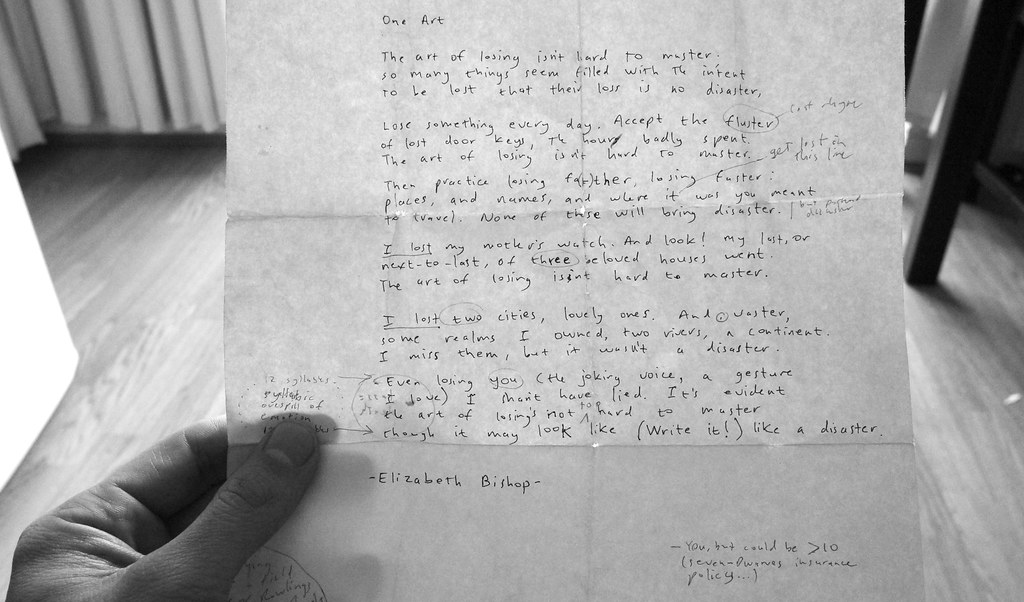
 The mind is a lemon squeezer. The poem is a lemon. When you cut a poem open and begin to learn it, pressing the poem into the grooves of the mind, rotating it back and forth in memory until it cleaves to the mind, releasing more and more of its meaning, you get the best of the poem and it gets the best of you.
The mind is a lemon squeezer. The poem is a lemon. When you cut a poem open and begin to learn it, pressing the poem into the grooves of the mind, rotating it back and forth in memory until it cleaves to the mind, releasing more and more of its meaning, you get the best of the poem and it gets the best of you. The morning mind is overfull, not sure where to place itself. The poem gives it a place to settle.
The morning mind is overfull, not sure where to place itself. The poem gives it a place to settle. There is an approach to reading (broadly speaking Structuralism, or Literary
There is an approach to reading (broadly speaking Structuralism, or Literary 
 Hopkins loved words.
Hopkins loved words. In the first couple of weeks of my By Heart project, I thought I might return to poems I’ve had a crack at learning before, but never giving the memorization process enough time to bed in.
In the first couple of weeks of my By Heart project, I thought I might return to poems I’ve had a crack at learning before, but never giving the memorization process enough time to bed in. I don’t think I realised how nourishing a single poem might be until I started learning them by heart. Just a couple of lines of language, returned to, day in day out, engaged with earnestly, like prayer, or telling someone you love them.
I don’t think I realised how nourishing a single poem might be until I started learning them by heart. Just a couple of lines of language, returned to, day in day out, engaged with earnestly, like prayer, or telling someone you love them. [Read “Everything Is Waiting For You” by David Whyte
[Read “Everything Is Waiting For You” by David Whyte  So I begin carrying around the poem copied neatly onto a 5″ x 3″ Correspondence Card, the card starting to feel intimately used as well as useful, on its way to disintegration through repeated folding.
So I begin carrying around the poem copied neatly onto a 5″ x 3″ Correspondence Card, the card starting to feel intimately used as well as useful, on its way to disintegration through repeated folding. I’m all for New Year’s resolutions.
I’m all for New Year’s resolutions.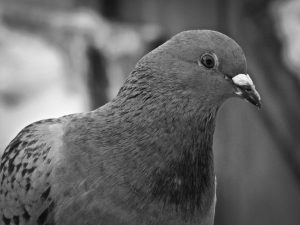 For it is, primarily that (a place of refuge), and not just for me.
For it is, primarily that (a place of refuge), and not just for me. The shadow-side of patience is procrastination. A form of forestalment, with all the discomfort of inertia, torpidity, but none of the dopamine-fuelled incentivizers. As Hesiod, one of the earliest writers on the subject gravely remarks: “a man who puts off work is always at hand-grips with ruin”. Yes, sometimes, it really does feel like that.
The shadow-side of patience is procrastination. A form of forestalment, with all the discomfort of inertia, torpidity, but none of the dopamine-fuelled incentivizers. As Hesiod, one of the earliest writers on the subject gravely remarks: “a man who puts off work is always at hand-grips with ruin”. Yes, sometimes, it really does feel like that. All things come to he who waits, is not entirely true. Even the Victorian poet Violet Fane who coined the phrase feels the need to qualify it in the next line of her poem:
All things come to he who waits, is not entirely true. Even the Victorian poet Violet Fane who coined the phrase feels the need to qualify it in the next line of her poem: Why did I ever doubt I’d get flowers from Jenny?
Why did I ever doubt I’d get flowers from Jenny?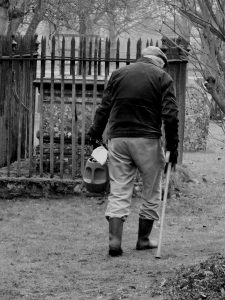 If you don’t water your plants carefully and consistently, especially those not embedded in earth, but exiled in pots and planters, they’ll soon let you know, becoming pallid, etiolated husks of their former selves. Take this poor wilty tomatillo plant on the left that greeted me a few mornings back: not a happy camper.
If you don’t water your plants carefully and consistently, especially those not embedded in earth, but exiled in pots and planters, they’ll soon let you know, becoming pallid, etiolated husks of their former selves. Take this poor wilty tomatillo plant on the left that greeted me a few mornings back: not a happy camper.
 If you’re a Gardener’s World fan, you probably tune in as much to see what a Golden Retriever called Nigel is up to at Longmeadow (mostly activities involving tennis balls) as what his owner Monty Don might be planting that week.
If you’re a Gardener’s World fan, you probably tune in as much to see what a Golden Retriever called Nigel is up to at Longmeadow (mostly activities involving tennis balls) as what his owner Monty Don might be planting that week. The
The  It’s about ten to ten in the evening and I’m standing in semi-darkness beating out the rhythm to
It’s about ten to ten in the evening and I’m standing in semi-darkness beating out the rhythm to  Gardeners take a lot of pride in their gardens. Especially in those plants we’ve grown from seed or a cutting. It’s a parental pride, a feeling of having been there at the moment when the thing before you was an almost-nothing, a blink-and-you’ll-miss-it seed. It’s a pride also borne out of constant fussing and nurturing of our seedling as they matured from vulnerable almost-somethings to very needy small plants almost indistinguishable from the weeds around them, to finally the pleasures of foliage, buds and Bloomsday (not to be confused, though sometimes coinciding with that other
Gardeners take a lot of pride in their gardens. Especially in those plants we’ve grown from seed or a cutting. It’s a parental pride, a feeling of having been there at the moment when the thing before you was an almost-nothing, a blink-and-you’ll-miss-it seed. It’s a pride also borne out of constant fussing and nurturing of our seedling as they matured from vulnerable almost-somethings to very needy small plants almost indistinguishable from the weeds around them, to finally the pleasures of foliage, buds and Bloomsday (not to be confused, though sometimes coinciding with that other  Every day, the hundreds of fronds that make up the lettuce in my raised beds launch into a Lactuca Sativa version of that 80s stadium anthem by Simple Minds:
Every day, the hundreds of fronds that make up the lettuce in my raised beds launch into a Lactuca Sativa version of that 80s stadium anthem by Simple Minds: Having done a bit of a U-turn recently on the Cottage Garden ethos of ornamentals and edibles cheek by jowl, I’ve been clearing some sunny 3ft x 5 ft beds in the front garden with the express purpose of filling them with plants that’ll give me dizzying, eye-popping, heart-pumping highs.
Having done a bit of a U-turn recently on the Cottage Garden ethos of ornamentals and edibles cheek by jowl, I’ve been clearing some sunny 3ft x 5 ft beds in the front garden with the express purpose of filling them with plants that’ll give me dizzying, eye-popping, heart-pumping highs. A few months ago I planted some Jasmine beesianum (I’ll call her Jasbee for short) near one of the the wooden trellises with the hope of having her “delicate pink trumpets and a heavenly scent” (oh the come-hither descriptions of plant packaging blurb!) complement the deep purple of summer delphiniums,
A few months ago I planted some Jasmine beesianum (I’ll call her Jasbee for short) near one of the the wooden trellises with the hope of having her “delicate pink trumpets and a heavenly scent” (oh the come-hither descriptions of plant packaging blurb!) complement the deep purple of summer delphiniums,  Yesterday, I woke up, looking forward, with possibly more ardour than anything else in my day to come, to digging a hole.
Yesterday, I woke up, looking forward, with possibly more ardour than anything else in my day to come, to digging a hole. As I
As I  Anxiety is a complex emotional response that’s similar to fear. Both arise from similar brain processes and cause similar physiological and behavioral reactions; both originate in portions of the brain designed to help all animals deal with danger.
Anxiety is a complex emotional response that’s similar to fear. Both arise from similar brain processes and cause similar physiological and behavioral reactions; both originate in portions of the brain designed to help all animals deal with danger.
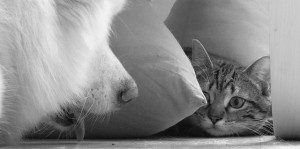 Making great agreements is an art form. Trust is built or broken around agreements that are kept or not kept. Whether or not we keep our agreements is quietly (or sometimes noisily) noted by those around us, who view our character through the lens of
Making great agreements is an art form. Trust is built or broken around agreements that are kept or not kept. Whether or not we keep our agreements is quietly (or sometimes noisily) noted by those around us, who view our character through the lens of  Does that sound wacky? I expect it does based on the pretty consistent reactions I have gotten in the past when I proposed this idea. People are just not used to a co-creative mode of relating, where we get to be equal partners in creating new ideas and solutions. Welcome to this new world!
Does that sound wacky? I expect it does based on the pretty consistent reactions I have gotten in the past when I proposed this idea. People are just not used to a co-creative mode of relating, where we get to be equal partners in creating new ideas and solutions. Welcome to this new world! Each person is 100 percent responsible for making a great agreement. That means that strategies people have traditionally relied on to get our way (whining, cajoling, demanding, wheedling, pressuring, withdrawing, stonewalling, “forgetting,” going dumb, resisting, manipulating, bargaining, arguing, giving up) aren’t actually useful here. In this new world of great and successful agreements, finding what works for both people is the team goal. That requires each person to show up, be clear, be unarguable, and follow through with what she or he agrees to.
Each person is 100 percent responsible for making a great agreement. That means that strategies people have traditionally relied on to get our way (whining, cajoling, demanding, wheedling, pressuring, withdrawing, stonewalling, “forgetting,” going dumb, resisting, manipulating, bargaining, arguing, giving up) aren’t actually useful here. In this new world of great and successful agreements, finding what works for both people is the team goal. That requires each person to show up, be clear, be unarguable, and follow through with what she or he agrees to. Getting to the bottom line is the key step. It can take some time to get to what this is. For example, “I want to paint the house green” might shift to “I want to look at our house and feel soothing inside.”
Getting to the bottom line is the key step. It can take some time to get to what this is. For example, “I want to paint the house green” might shift to “I want to look at our house and feel soothing inside.” Having a baby. Moving for one person’s job . . . again. Having family move in. Selling everything to live on a sailboat. How does this process work for the really big decisions?
Having a baby. Moving for one person’s job . . . again. Having family move in. Selling everything to live on a sailboat. How does this process work for the really big decisions? This tool contains everything I’ve been walking you through, so give yourselves plenty of practice with it. Take it slowly. And when you can get all the way through the steps, please celebrate — you’ve just crossed the bridge to a radically alive relationship!
This tool contains everything I’ve been walking you through, so give yourselves plenty of practice with it. Take it slowly. And when you can get all the way through the steps, please celebrate — you’ve just crossed the bridge to a radically alive relationship! ONCE A COUPLE has made a commitment to stay together and work on their relationship, the next logical step is to help them become allies, not enemies. It’s fruitless to take two people who are angry with each other and try to lead them along a path of spiritual and psychological growth—they would spend too much time trying to knock each other off the road. In order to make the surest and fastest progress toward their relationship vision, they need to become friends and helpmates.
ONCE A COUPLE has made a commitment to stay together and work on their relationship, the next logical step is to help them become allies, not enemies. It’s fruitless to take two people who are angry with each other and try to lead them along a path of spiritual and psychological growth—they would spend too much time trying to knock each other off the road. In order to make the surest and fastest progress toward their relationship vision, they need to become friends and helpmates.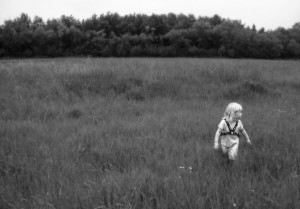 YEARS AGO Harville Hendrix, the originator of this exercise, was resistant to the idea of such a direct approach to changing his clients’ behaviour. Coming from a psychoanalytic tradition, he was taught that the goal of a therapist was to help clients remove their emotional blocks. Once they had correctly linked feelings they had about their partners with needs and desires left over from childhood, they were automatically supposed to evolve a more rational, adult style of relating.
YEARS AGO Harville Hendrix, the originator of this exercise, was resistant to the idea of such a direct approach to changing his clients’ behaviour. Coming from a psychoanalytic tradition, he was taught that the goal of a therapist was to help clients remove their emotional blocks. Once they had correctly linked feelings they had about their partners with needs and desires left over from childhood, they were automatically supposed to evolve a more rational, adult style of relating. A BEHAVIORAL APPROACH proved especially useful in restoring a couple’s sense of love and goodwill. In his book, Helping Couples Change: A Social Learning Approach to Marital Therapy, psychologist Richard Stuart presents an exercise for couples that helps them feel more loving toward each other simply by engaging in more loving behaviours.
A BEHAVIORAL APPROACH proved especially useful in restoring a couple’s sense of love and goodwill. In his book, Helping Couples Change: A Social Learning Approach to Marital Therapy, psychologist Richard Stuart presents an exercise for couples that helps them feel more loving toward each other simply by engaging in more loving behaviours. “Well, the day after our appointment, I found myself driving around town in a black mood,” Dennis volunteered. “I can’t even remember what made me feel so down. Anyway, I decided that it was as good a time as any to do what you asked, so I stopped off at a variety store and bought Harriet some flowers. That was one of the requests on her list. So I gritted my teeth and picked out some daisies, because I remembered she always liked daisies. The shop assistant asked me if I wanted a note card and I said, ‘Why not?’ I remember saying to myself, ‘We’re paying Dr. Hendrix a lot of money to make things better, so I’d better do this all the way.’ When I came home, I signed the card ‘I love you.’” He paused for a moment. “The thing that surprised me, Harville, was that, as I handed Harriet the flowers, I really did care for her.”
“Well, the day after our appointment, I found myself driving around town in a black mood,” Dennis volunteered. “I can’t even remember what made me feel so down. Anyway, I decided that it was as good a time as any to do what you asked, so I stopped off at a variety store and bought Harriet some flowers. That was one of the requests on her list. So I gritted my teeth and picked out some daisies, because I remembered she always liked daisies. The shop assistant asked me if I wanted a note card and I said, ‘Why not?’ I remember saying to myself, ‘We’re paying Dr. Hendrix a lot of money to make things better, so I’d better do this all the way.’ When I came home, I signed the card ‘I love you.’” He paused for a moment. “The thing that surprised me, Harville, was that, as I handed Harriet the flowers, I really did care for her.” WHY IS THIS simple exercise so effective? The obvious reason is that, through daily repetitions of positive behaviours, your old brain begins to perceive your partner as “someone who nurtures me.”
WHY IS THIS simple exercise so effective? The obvious reason is that, through daily repetitions of positive behaviours, your old brain begins to perceive your partner as “someone who nurtures me.” Most relationships are run like a commodities market, with loving behaviours the coin in trade. But this kind of “love” does not sit well with our old repitilian brains (the part of us that can feel very scared, unsafe, and so responds in a fight-flight-freeze way). If John rubs Maya’s shoulders in the hope that she will let him spend the day going fishing, a built-in sensor in Maya’s head goes: “Look out! Price tag attached. There is no reason to feel good about this gift, because I’ll have to pay for it later.” Unconsciously she rejects John’s attentions, because she knows that they were designed for his benefit, not hers. The only kind of love that her old brain will accept is the kind with no strings attached: “I will rub your shoulders because I know that you would like it.” The back rub has to come as a “gift.”
Most relationships are run like a commodities market, with loving behaviours the coin in trade. But this kind of “love” does not sit well with our old repitilian brains (the part of us that can feel very scared, unsafe, and so responds in a fight-flight-freeze way). If John rubs Maya’s shoulders in the hope that she will let him spend the day going fishing, a built-in sensor in Maya’s head goes: “Look out! Price tag attached. There is no reason to feel good about this gift, because I’ll have to pay for it later.” Unconsciously she rejects John’s attentions, because she knows that they were designed for his benefit, not hers. The only kind of love that her old brain will accept is the kind with no strings attached: “I will rub your shoulders because I know that you would like it.” The back rub has to come as a “gift.”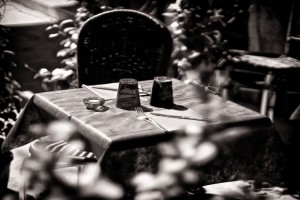 Time: Approximately 60 minutes.
Time: Approximately 60 minutes.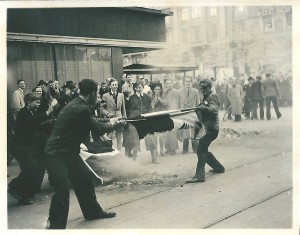 A certain degree of resistance is to be expected. When a husband and wife have been treating each other like enemies for a while, it’s going to feel strange to start writing love notes again. The exercise is going to feel artificial and contrived (which, of course, it is), and to the old threat-perceiving brain anything that is not routine and habituated feels unnatural. The only way to lessen this automatic resistance is to repeat a new behaviour often enough so that it begins to feel familiar and therefore safe.
A certain degree of resistance is to be expected. When a husband and wife have been treating each other like enemies for a while, it’s going to feel strange to start writing love notes again. The exercise is going to feel artificial and contrived (which, of course, it is), and to the old threat-perceiving brain anything that is not routine and habituated feels unnatural. The only way to lessen this automatic resistance is to repeat a new behaviour often enough so that it begins to feel familiar and therefore safe. You do not have to be good.
You do not have to be good. One of the best ways to cultivate gratitude is to establish a daily practice in which you remind yourself of the gifts, grace, benefits, and good things you enjoy. One of the best ways to do this is keeping a daily journal in which you record the blessings you are grateful for. Emmons’ extensive research has shown that this technique makes people happier. When we are grateful, we affirm that a source of goodness exists in our lives. By writing each day, we magnify and expand upon these sources of goodness. Setting aside time on a daily basis to recall moments of gratitude associated with even mundane or ordinary events, your personal attributes, or valued people in your life gives you the potential to interweave and thread together a sus- tainable life theme of gratefulness, just as it nourishes a fundamental life stance whose thrust is decidedly affirming.
One of the best ways to cultivate gratitude is to establish a daily practice in which you remind yourself of the gifts, grace, benefits, and good things you enjoy. One of the best ways to do this is keeping a daily journal in which you record the blessings you are grateful for. Emmons’ extensive research has shown that this technique makes people happier. When we are grateful, we affirm that a source of goodness exists in our lives. By writing each day, we magnify and expand upon these sources of goodness. Setting aside time on a daily basis to recall moments of gratitude associated with even mundane or ordinary events, your personal attributes, or valued people in your life gives you the potential to interweave and thread together a sus- tainable life theme of gratefulness, just as it nourishes a fundamental life stance whose thrust is decidedly affirming.![[Photo by Michelle Robinson: Black Dog Visitation series]](http://stevewasserman.co.uk/wp-content/uploads/2015/11/19942697499_e750dbfbb3_z-1-300x225.jpg)
![[Photo by Guido Caprini]](http://stevewasserman.co.uk/wp-content/uploads/2015/11/14393075726_2bfef29951_z-300x170.jpg)
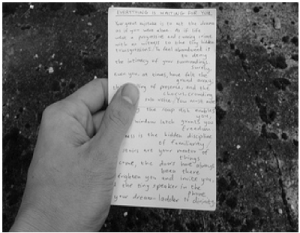 Surveys have revealed that people spend more time praying than doing just about anything else. 72 percent of people asked say that they pray at least once a day; 75 percent of people say they would like to spend more time in prayer, and over half (51 percent) say they pray before a meal. Most of the prayers are casually conversational rather than liturgically formal.
Surveys have revealed that people spend more time praying than doing just about anything else. 72 percent of people asked say that they pray at least once a day; 75 percent of people say they would like to spend more time in prayer, and over half (51 percent) say they pray before a meal. Most of the prayers are casually conversational rather than liturgically formal. Good health; being alive; no more skin allergies; I’m not fat; white teeth; exercise; eyes; ears; touch; physical strength; afternoon nap; ability to breathe; modern medicine, energy to get through the day; no broken bones. Each of these bodily-related blessings appeared in journals that Emmons’ research participants have kept. The physicality of gratitude is noticeable as gratefulness for the functioning of one’s body, recovery from illness, or for just being alive are some of the most commonly mentioned themes. Nearly 80 percent of his research participants say they are grateful for their health, or the health of family members, making it the most cited trigger of gratitude. Another frequently mentioned source of gratitude is the senses – the ability to touch, see, smell, taste, and hear.
Good health; being alive; no more skin allergies; I’m not fat; white teeth; exercise; eyes; ears; touch; physical strength; afternoon nap; ability to breathe; modern medicine, energy to get through the day; no broken bones. Each of these bodily-related blessings appeared in journals that Emmons’ research participants have kept. The physicality of gratitude is noticeable as gratefulness for the functioning of one’s body, recovery from illness, or for just being alive are some of the most commonly mentioned themes. Nearly 80 percent of his research participants say they are grateful for their health, or the health of family members, making it the most cited trigger of gratitude. Another frequently mentioned source of gratitude is the senses – the ability to touch, see, smell, taste, and hear. Enter Emmons’ family home and one of the first things you will see is a ceramic plaque above the hallway mirror with the words GIVE THANKS carved in the center. Help yourself to a drink from the refrigerator and you might see a magnet on the door quoting Eleanor Roosevelt: “Yesterday is history, tomorrow is mystery … today is a gift.” Now go over to the family room and look at the bookcase to the right of the windows. On one shelf is a pewter paperweight given to him by a close friend containing a passage from the author Melody Beattie: “Gratitude can turn a meal into a feast, a house into a home, a stranger into a friend:’
Enter Emmons’ family home and one of the first things you will see is a ceramic plaque above the hallway mirror with the words GIVE THANKS carved in the center. Help yourself to a drink from the refrigerator and you might see a magnet on the door quoting Eleanor Roosevelt: “Yesterday is history, tomorrow is mystery … today is a gift.” Now go over to the family room and look at the bookcase to the right of the windows. On one shelf is a pewter paperweight given to him by a close friend containing a passage from the author Melody Beattie: “Gratitude can turn a meal into a feast, a house into a home, a stranger into a friend:’ There is some research which shows that swearing a vow to perform a behaviour actually does increase the likelihood that the action will be executed. In one such study, members of a local YMCA who decided to participate in the Twelve-Week Personal Fitness Program agreed to “exercise three days per week for twelve weeks and beyond at the Y.” Once making the decision to participate, the experimental group was sworn to perform the promised behaviour. A second group signed a written commitment to perform the promised behaviour, and a third, control group, did not make any form of commitment.
There is some research which shows that swearing a vow to perform a behaviour actually does increase the likelihood that the action will be executed. In one such study, members of a local YMCA who decided to participate in the Twelve-Week Personal Fitness Program agreed to “exercise three days per week for twelve weeks and beyond at the Y.” Once making the decision to participate, the experimental group was sworn to perform the promised behaviour. A second group signed a written commitment to perform the promised behaviour, and a third, control group, did not make any form of commitment. In the late 1930s, the amateur linguist Benjamin Lee Whorf posed the theory that language determines the nature and content of thought. This “Whorfian” hypothesis inspired decades of research in a variety of disciplines, including linguistics, psychology, philosophy, anthropology, and education. To this day, it has not been completely disputed or defended but has continued to intrigue researchers around the world. Many have adopted a weaker form of the hypothesis, namely that language influences how we think rather than determining, in a rigid fashion, the very content of the thoughts.
In the late 1930s, the amateur linguist Benjamin Lee Whorf posed the theory that language determines the nature and content of thought. This “Whorfian” hypothesis inspired decades of research in a variety of disciplines, including linguistics, psychology, philosophy, anthropology, and education. To this day, it has not been completely disputed or defended but has continued to intrigue researchers around the world. Many have adopted a weaker form of the hypothesis, namely that language influences how we think rather than determining, in a rigid fashion, the very content of the thoughts. An ingenious series of experiments conducted a number of years ago showed that when people mimicked the facial expressions associated with happiness, they felt happier – even when they did not know they were moving the “happy muscles” in their face. Researchers have found that smiling itself produces feelings of happiness. How were they kept in the dark? Simple. They were asked to hold a pencil with their teeth. Doing so tends to activate the muscle we use when we smile (the zygomatic major). This muscle lifts the corner of the mouth obliquely upwards and laterally and produces a characteristic smiling expression. Try it now. You will smile. Now, take that pencil and hold it in your lips, pointing it straight out. A different set of muscles are now activated, those that are involved in frowning (these are the ones targeted by Botox treatments). Why this clever ruse? You can’t let subjects in the study know that they are supposed to be feel-ing happy, because that would have unintended consequences on the behavioral rating of interest.
An ingenious series of experiments conducted a number of years ago showed that when people mimicked the facial expressions associated with happiness, they felt happier – even when they did not know they were moving the “happy muscles” in their face. Researchers have found that smiling itself produces feelings of happiness. How were they kept in the dark? Simple. They were asked to hold a pencil with their teeth. Doing so tends to activate the muscle we use when we smile (the zygomatic major). This muscle lifts the corner of the mouth obliquely upwards and laterally and produces a characteristic smiling expression. Try it now. You will smile. Now, take that pencil and hold it in your lips, pointing it straight out. A different set of muscles are now activated, those that are involved in frowning (these are the ones targeted by Botox treatments). Why this clever ruse? You can’t let subjects in the study know that they are supposed to be feel-ing happy, because that would have unintended consequences on the behavioral rating of interest.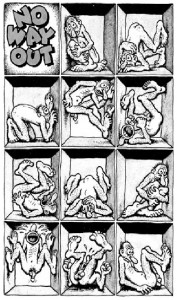 If we want to make the most out of opportunities to flex our gratitude muscles, then we must creatively look for new situations and circumstances in which to feel grateful. Just when I thought I had fully grasped the conceptual basis of gratitude, an article came across my desk describing two “anomalous cases” of gratitude not fitting the usual dynamic of the giving and receiving of goodness between benefactor and beneficiary.
If we want to make the most out of opportunities to flex our gratitude muscles, then we must creatively look for new situations and circumstances in which to feel grateful. Just when I thought I had fully grasped the conceptual basis of gratitude, an article came across my desk describing two “anomalous cases” of gratitude not fitting the usual dynamic of the giving and receiving of goodness between benefactor and beneficiary.





 Sometimes the words just won’t go in.
Sometimes the words just won’t go in.